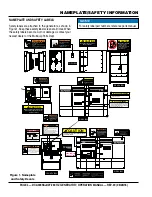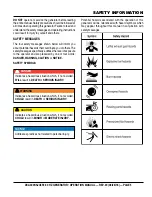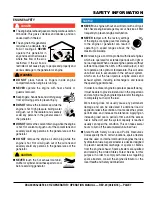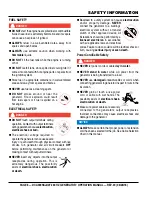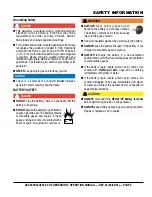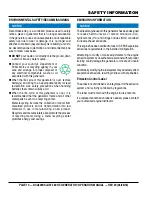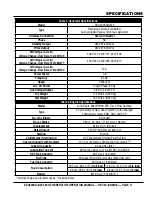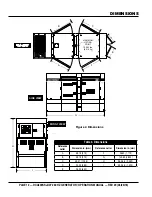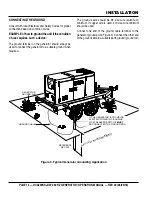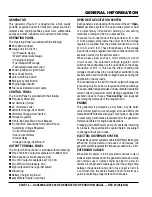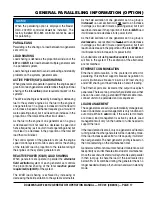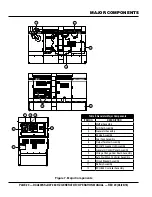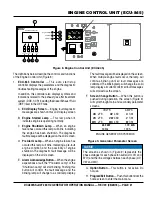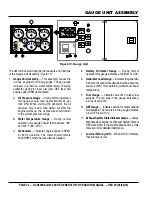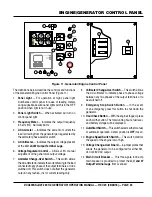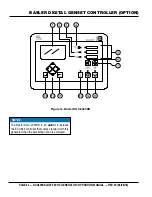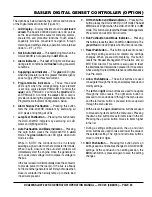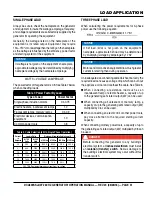
DCA300SSJU4F2 60 HZ GENERATOR• OPERATION MANUAL — REV. #0 (06/26/18) — PAGE 17
PARALLELING
Paralleling is the sharing of a load between two generator
sets or more.
LOAD SHARING
Load sharing is defined as the proportional division of the
kW
and
kVAR
total load between multiple generator sets
in a paralleled system.
Load sharing is essential to avoid overloading and stability
problems on the systems’ generator sets.
ACTIVE POWER (KW) LOAD SHARING
When generator sets operate in parallel, the engine speed
governor of each generator set determines the proportional
sharing of the total
active
power requirements (kW) of the
systems’.
The kW load sharing is achieved by increasing or decreasing
fuel to the systems’ engines. As the fuel to the engine of
one generator set in a group is increased it will not lead to
an increase in speed and hence frequency (as it would if it
were operating alone) but it will lead to an increase in the
proportion of the total kW load that it will deliver.
As the fuel to the engine of one generator set in a group
is decreased it will not lead to a decrease in speed and
hence frequency (as it would if it were operating alone) but
it will lead to a decrease in the proportion of the total kW
load that it will deliver.
The control system of the generator sets (via the engine
speed control system) monitors and controls the sharing
of the total kW load in proportion to the relative rating of
the engines on the systems’ generator sets.
REACTIVE POWER (KVAR) LOAD SHARING
When generator sets operate in parallel the
alternator
field excitation
system of each generator set controls
the proportional sharing of the total
reactive power
requirements (kVAR)
of the system.
The kVAR load sharing is achieved by increasing or
decreasing the field excitation to the systems’ alternators
NOTICE
When the paralleling option is employed, the Basler
DGC-2020HD controller
must
be installed. The
factory installed ECU-845 controller cannot be used
for paralleling.
GENERAL PARALLELING INFORMATION (OPTION)
As the field excitation of one generator set in a group is
increased
i.e. over excited it will
not
lead to an increase
in voltage (as it would if it were operating alone) but It will
lead to an increase in the proportion of the total
kVAR
load
it will deliver and a decrease in its power factor.
As the field excitation of one generator set in a group is
decreased
i.e. over excited it will
not
lead to an decrease
in voltage (as it would if it were operating alone) but It will
lead to an decrease in the proportion of the total
kVAR
load
it will deliver and a increase in its power factor.
An undesirable circulating
reactive current
(cross current)
will flow in the system if the excitation of the alternators
are not matched.
ETHERNET COMMUNICATION
Ethernet communication is the preferred method for
paralleling. This method supports breaker negotiation to
avoid simultaneous breaker closures, kW load sharing
and kVAR sharing, soft load transfers on and off loading.
The Ethernet ports are located at the output bus splash
panel area. There are two ports which are identical so either
one can be used. Using a standard Ethernet cable, inter-
connect units to be paralleled and or sequenced.
LOAD MANAGEMENT
These generators are set up to automatically manage load,
based on demand. Load management is only functional in
auto mode. While in
auto
mode, if the auto start contacts
are closed, load management is active by default. Load
management will only run the number of units needed to
support the load.
If the load demand is small, only one generator will remain
running while the other generators will be in standby mode.
If the load increases above 80% of its capacity, it will start
the next generator. The next generator priority is based on
the time remaining on the maintenance timer.
Generators with more time until scheduled maintenance will
take priority over units that are almost due for maintenance.
Once the second unit starts it will synchronize and parallel
in then ramp up to share the load. If the load levels drop
below 35% of its combined rating, the generator that is no
longer needed will ramp off, shut down and wait in standby
mode.
Содержание WHISPERWATT DCA300SSJU4F2
Страница 13: ...DCA300SSJU4F2 60 HZ GENERATOR OPERATION MANUAL REV 0 06 26 18 PAGE 13 NOTES ...
Страница 62: ...PAGE 62 DCA300SSJU4F2 60 HZ GENERATOR OPERATION MANUAL REV 0 06 26 18 ENGINE WIRING DIAGRAM ECU 845 ...
Страница 73: ...DCA300SSJU4F2 60 HZ GENERATOR OPERATION MANUAL REV 0 06 26 18 PAGE 73 NOTES ...


